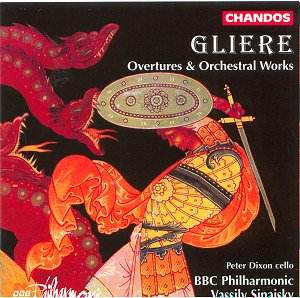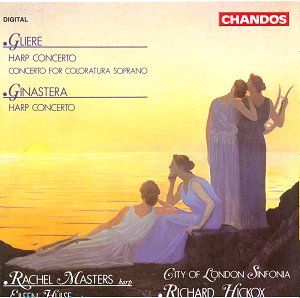REINHOLD GLIERE (1875-1956)
The 'other' orchestral works on CHANDOS
+++++++++++++++++++++++++++++++++++
REINHOLD GLIERE
(1875-1956)
Bronze Horseman suite
Horn Concerto
 Richard Watkins
(horn)
Richard Watkins
(horn)
BBCPO/Edward Downes
 CHANDOS CHAN 9379
[70.16]
CHANDOS CHAN 9379
[70.16]
Crotchet

Gliere's reputation rests on some ballet music (principally The Red
Poppy) and the epic length Ilya Mouramets symphony (No. 3). The
Symphony has been recorded by a range of distinguished conductors. Both Ormandy
and Stokowski have recorded it in cut versions. Unicorn let Harold Farberman
loose on the symphony in a very full version back in the 1970s. There have
also been recordings of the full version by Nathan Rachlin, Donald Johanos,
Yoav Talmi and Edward Downes.
Gliere was no slouch when it came to producing music and while you can at
times catch a sense of the 'conveyor belt' about the stream of works the
predominant impression is of a pleasantly catchy character. Downes is a well
known Russophile. His work on Prokofiev scores is well known. He produced
and broadcast performing versions of his early operas and his dedication
to obscure but accessible music places him the same category as the late
Norman Del Mar.
The Bronze Horseman encompasses many stylistic streams. The first movement
reeks of the Meistersinger overture, the second has traces of Borodin's DNA.
There is a proud and dainty grace about this music which places it as a successor
to Glazunov's ballet scores. The BBCPO play idiomatically. The Parasha movement
has the strength and lyric sweep of Rosenkavalier but with helpings of
Tchaikovsky and Khachaturyan along the way. The music has a most persuasive
lilt: oriental and sloe-eyed.. The Lyric Scene is operatic. It would be very
easy to hear a voice in this music e.g. in line taken by the clarinet. The
Waltz is in the robust grand manner - generous infusions of oompah and the
glinting of small bells. This episode is obstreperous enough to slide neatly
into Samuel Barber's Souvenirs. Anticipation thunders and lightens
in the grandest manner - a dark sky riven by murderous conflict. The final
Hymn to a Great City (adopted by Leningrad) is a slow rising surging
paean which includes a piano part in its wave crests of sound. One might
wonder if parts of this grand statuary might easily have read across into
a National Socialist rally surrounded by Albert Speer's 'kolossal' architecture.
Can't help falling for its awesome overstatement.
The Horn Concerto sings sturdily and in Germanic romantic accents sounding
somewhat like the Schoeck and the Richard Strauss (No. 1). In the first movement
a most striking melody is rollingly taken by Richard Watkins' solo instrument.
The music becomes more Slavonic in the final movement. though this soon dispels
in deference to a flavour of Teutonic trauer music.
Impressive recording quality is a given in all the Chandos Gliere series.

+++++++++++++++++++++++++++++++++++++++++++++++++++++++++++
REINHOLD GLIERE
(1875-1956)
Overtures and Orchestral Works
Gyul'sara overture (1936)
Concert Waltz
Shakh-Senem overture (1925)s
Ballad (1902) *
Overture on Slavonic Themes (1941)
Heroic March for Buryat-Mongolian ASSR
Holiday at Ferghana overture
(1940)
 Peter Dixon
Peter Dixon
BBCPO/Edward Downes
 CHANDOS CHAN 9518
[75.30]
CHANDOS CHAN 9518
[75.30]
Crotchet

This generous anthology of the smaller pieces by Gliere suggests a library
project. There is not a single piece here which has any fame. Shakh-Senem
may be known to a few but on this disc that work is the closest approximation
to a 'known quantity'.
The Concert Waltz is eruptive and grand in the manner of the two Glazunov
concert waltzes. It has none of the psychological crunch of a Prokofiev waltz.
The Ballad (an early piece) is pleasantly kin to the Glazunov and
Frank Bridge salon pieces. The Overture on Slavonic Themes is strangely
Beethovenian (02.01), in parts, fugal (05.36) - broadly romantic but finally
uncompelling.
Gyul'Sara is the longest piece on the disc at just over 16 minutes. Here
you need to think in terms of a modernised Russian Easter Festival
Overture with oriental accents, a central fugue and some simply magnificent
brass writing out of Sibelius Symphony No. 1 and En Saga. Did Basil
Poledouris hear this before writing the music for the Conan films?
Shakh-Senem (an opera premiered in Baku and dubbed The Worker of Baku
in 1934) is similarly sloe-eyed and Arabian (try 06.02) in the manner
of Rimsky's Antar, Balakirev's Tamar (at least the sinister
dance sections) and Borodin's Prince Igor. Barbaric grandeur and exoticism
strike Hispanic sparks off each other (07.30).
The Heroic March has an abrasively crunching tread which generates
some affirmative satisfaction. There is some great high contour work for
the horn choir at 03.14. Well worth hearing and as David Nice says in his
far from euphoric notes, this work is closer to a tone poem than to a gormless
march.
To close proceedings ten minutes worth of Holiday at Ferghana. More
exotic Middle-Eastern markets, camels and bazaars. Thank Heavens there is
none of the 'bizarre' cheapskate atmosphere of the pier end band. Instead
the music has an authentic snap and finger-cymbal sparkle. If anything the
linkage is with the sincere exoticism achieved by Biarent and Schmitt.
There is more Gliere to come. Let us not slight unheard the overture Twenty
Five Years of the Red Army, the marching song Hitler's End Will
Come, Victory Overture, and what about a major suite from The
Red Poppy ballet (1927).
Now Chandos (and Sir Edward) is there any chance of a Lev Knipper, Ivan
Dzerzhinsky and Yuri Shaporin orchestral series? If this is all too obscure
why not a commercially astute move to record the unrecorded Miaskovsky
symphonies. Numbers 4, 14 and 20 await you. The world of Russian music collectors
waits to snap up the first commercial recordings of these works.
For now this disc is the most intriguing of the Chandos series - at least
outside the three symphony discs.

++++++++++++++++++++++++++++++++++++++++++++++++++++++++++
REINHOLD GLIERE
(1875-1956)
Harp Concerto (1938) 26.59
Coloratura Soprano Concerto (1943)
13.54
GINASTERA
Harp Concerto (1956)
23.43
 Rachel Masters (harp)
Rachel Masters (harp)
Eileen Hulse (soprano)
 City of London Sinfonia/Richard
Hickox
City of London Sinfonia/Richard
Hickox
 CHANDOS CHAN 9379
[68.13]
CHANDOS CHAN 9379
[68.13]
Crotchet

Self-evidently this was not designed as part of the Gliere/Downes series
which it predates by at least four years. Nevertheless it deserves to be
read in that context.
This collection comprises three substantial works: two harp concertos and
a soprano concerto. This amounts to almost three quarters of an hour of music
by Gliere plus Ginastera's harp concerto.
The Gliere Harp Concerto is a product of the late 1930s and is contemporary
only in terms of the time-line. It is unchallenging harmonically. Its sentimental
redolence is Gallic in orientation with recognisably Russian elements only
intruding in the last of the three movements. The other two have an undemanding
charm which make this an easy companion for the Boieldieu concerto. The
occasional nondescript invention that hangs over the first two movements
of the harp concerto do it few favours.
The soprano concerto is a stronger work and more easily holds the attention
The first of the two movements (andante) is lyrical and recalls the Rachmaninov
Vocalise rather strongly. The voice is deployed with little regard to the
practicalities of breath control. In many ways this can be looked at as violin
concerto manqué simply written for soprano voice. Eileen Hulse's voice
is appositely attuned to the work and is superior to the cavernous and matronly
tones of Joan Sutherland whose recording was made for Decca. The second movement
melds Grand Hotel style with the lyrical flood of the first movement. Ms
Hulse's attack and the steadiness of her tone coupled with precision of attack
is an outstanding asset especially in the chuckling duo between the voice
and the flute at 03.12.
The Ginastera is a world away from Gliere. His harp concerto has taut attack
and a springy and fragile brightness which is a breath of fresh air after
the pleasantries of the Gliere. It is not short on dreamy tunefulness - try
1.55 in the first movement before it gives way an aggressive hunt sequence.
The premiere was given by Nicanor Zabaleta (an artist much associated with
Deutsche Grammophon) who also advised the composer on the composition. The
work was commissioned by Edna Philips harpist of the Philadelphia Orchestra.
The modern score is added further zest by a far from laid back percussion
section of 28 instruments.
Rachel Masters (whose Chandos disc of the Alwyn Lyra Angelica is very
fine indeed) is fully the equal of the challenges of both concertos and gives
the impression of comprehensive engagement.
There are other recordings of the Ginastera and the Gliere harp concertos
but no identical coupling. The presence of the Ginastera is welcome to provide
contrast with the tendency of the Gliere works to doodle in bland orthodoxy.
Decent though hardly generous notes.

